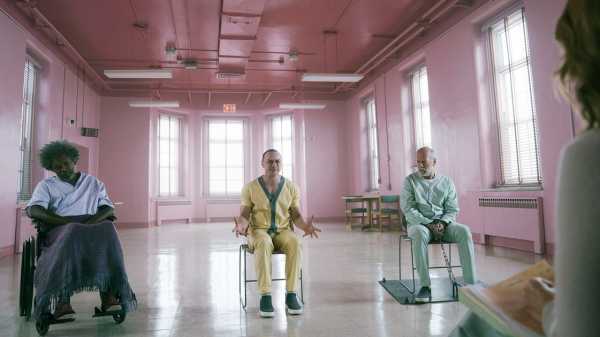
There’s almost no way to talk about the plot of M. Night Shyamalan’s new thriller, “Glass,” without spoilers, but not to worry—the plot is among the movie’s least-significant elements. What matters in “Glass” is its peculiar status as a self-commenting and self-reflecting work. It is propelled by no urgency and no dramatic stakes other than the recombination of two commercially successful films into a hybrid sequel. And yet it’s a fascinating reflection of something more substantial than the jigsaw-puzzle fit of Shyamalan’s script and the vague spiritualism of his artistic imagination, because it’s one of a recent batch of similarly self-referential big-budget movies made by celebrated pop-cinema auteurs who have struggled to maintain their primacy in present-day Hollywood.
The ending of Shyamalan’s 2016 film, “Split,” offered a winking connection to his 2000 film, “Unbreakable,” and “Glass” splices those two plotlines together. Elijah Price (Samuel L. Jackson), the murderous mastermind of “Unbreakable,” and Kevin Wendell Crumb (James McAvoy), the psychopathic, multiple-personality killer in “Split,” are both patients in the same Philadelphia-area hospital for the criminally insane. They’re soon joined there by David Dunn (Bruce Willis), the hero of “Unbreakable,” and the three characters’ tangled lines of collaboration and competition—stoked by the involvement of the hospital’s medical director, Dr. Ellie Staple (Sarah Paulson)—result in a violent confrontation.
In “Unbreakable,” Elijah presents comic books as a primordial scripture in disguise, which records historical events in mythological form. That movie was released in 2000, before the superhero-industrial complex took over popular cinema, and before critics began to bend themselves into superheroic contortions to justify the quantity of editorial attention they were lavishing on it. In the years that followed, not only did superhero movies come to dominate the box-office and the realm of celebrity but they also invaded the auteur cinema, with movies such as “The Dark Knight”; in that backwash, Shyamalan’s commercial success and critical acclaim simultaneously vanished.
“Glass” is a scaled-down movie that, like “Split,” is centered on a single location (the hospital), offering a drama of modest scope that ratchets up suspense with a lurching, self-aware mechanism. With “Unbreakable,” Shyamalan offered a naturalistic version of superhero stories; he detached them from the specific characters and mythologies of comic-book imaginings (and looked askance at the fetishization of their creators). In “Glass,” he goes further. As in “Unbreakable,” but much more so, the characters provide commentary in the course of the film—asides and declarations about the nature of superhero stories and where the plot points at hand fit into the archetypal schema—that undergirds the action, sets out the characters’ motives, and defines the drama’s stakes.
A similar reflexivity—rooted in filmmakers’ confrontation with some of the modes of media that are drowning out their films—is the engine of two other recent movies. Steven Spielberg’s “Ready Player One” is a dystopian story of a future America in which success in an enormous online virtual-reality game with a pop-culture focus is the source of real-world rewards. And Robert Zemeckis’s “Welcome to Marwen”—based on the true story of a man who, after suffering brain damage, therapeutically creates and photographs scenes from a model Second World War village and battle site—fuses live action and computer animation to create miniature cinematic scenes that are suggestive of D.I.Y. versions of classic war films but also resemble YouTube videos.
In classic Hollywood, reflexivity was deployed, as in some nineteen-fifties comedies, largely as a gag. In the sixties, it became a matter and even a mark of art-house intricacy. For a generation of Hollywood filmmakers, in the seventies and beyond, who came into the industry with cinephilic scholarship and passion, it has been both a reflection of personal experience and a matter of service to fans who (largely thanks to the repetition-compulsions of television and home video) are likely to be pop-culture vultures of a similar voracity. The films by Shyamalan, Spielberg, and Zemeckis are more than merely self-referential; they give the impression that they’re creating and analyzing the conditions and terms of their own existence. However, the actual results are impersonal, devoid of the filmmakers’ personalities or traits; they’re meta for others, not for themselves. In “Glass,” Shyamalan, like Spielberg in “Ready Player One” or Zemeckis in “Welcome to Marwen,” offers reflexivity without a mirror.
A demotic structuralist, Shyamalan conceives of superheroes in terms of their powers, their points of vulnerability, and their motives. He gestures toward their subjective points of view without ever dramatizing their inner lives—because he isn’t so much a visionary filmmaker as he is a very skillful plotter who also has a suave, at times distinctive, but dully literal style. In “Unbreakable,” the drama involves Elijah’s cult of the image—the static image, the hand-drawn one of the world of comics. There, Shyamalan dramatizes an ideal of passionate taste as it shifts from appreciation into obsession, narcissism, villainy—yet there’s something of that connoisseurship benignly at work in his direction, in his own eye-catching craft of deft trickery. In “Glass,” there’s little of that flair in sight. What’s most notable about the film’s aesthetic is its texturelessness, the sense that the physical action is stilled and smoothed in a clear-blue gel of uniformity and indifference; it suggests a filmmaker on the outside looking in, and looking toward the next sequel. It’s a film not to watch but to have seen; its implications are far richer than its experiences.
At the beginning of “Unbreakable,” a curious title card about comic books notes both their cult following (“The average comic collector owns 3,312 comics. . .”) and their commercial success (“172,000 comics are sold in the U.S. every day. Over 62,780,000 each year”). In effect, Shyamalan begins that movie, about comic-book superheroes, by announcing their popularity as if it were news. Nearly twenty years later, there’s no longer any such need; Hollywood and its superhero franchises are all but coextensive, and Shyamalan’s confrontation with the ubiquity, popularity, and dominance of superheroes gives “Glass” a second-level urgency. It’s a missed opportunity—and perhaps a showdown or comeuppance deferred that his riffs on superheroes are based entirely in the nostalgia of comics, proceeding as if superhero movies, his nemeses, didn’t exist. Fascinatingly, there’s a character (no spoilers) whose function is analogous to that of a corporate overlord, manipulating superheroes and their images. Yet it’s telling that the plot hinges upon footage caught on surveillance cameras and disseminated in the form of viral videos and television, not movies. There is no character in “Glass” whose creative struggles are at all cognate with Shyamalan’s own.
Sourse: newyorker.com






